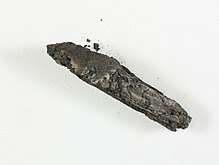En-Gedi Scroll

The En-Gedi Scroll is an ancient and fragile Hebrew parchment found in 1970 at Ein Gedi, Israel. It has been carbon-dated to the third or fourth century CE.[1] It contains a portion of the biblical Book of Leviticus. It is significant as one of the oldest portions of the Bible in existence.[2] The deciphered text fragment is identical to what was to become during the Middle Ages the standard text of the Hebrew Bible, known as the Masoretic text, which it precedes by several centuries, and constitutes the earliest evidence of this authoritative text version.
Discovery
The En-Gedi Scroll was discovered in 1970 at Ein Gedi in Israel. It was found in the burned remains of a Torah Ark in the ruins of the ancient synagogue at Ein Gedi.[3]
Text
According to radiocarbon testing performed by the Israel Antiquities Authority, the scroll has a probability of 88.9% of dating to 210-390 AD and 68.2% of dating to 235-340 AD.[1] The scroll was written at Ein Gedi where there was a community of Essenes,[4][5][6] the Jewish sect made famous for their probable association with the Dead Sea Scrolls.
The text deciphered so far consists of 18 complete lines and 17 partial lines of the first two chapters of Leviticus. The text is identical to the medieval era Masoretic Text,[7] unlike the Dead Sea scrolls which have variations from the Masoretic.[8] Emanuel Tov, of the Hebrew University of Jerusalem described the scroll "This is the earliest evidence of the exact form of the medieval text".[9]
Recovery
The ancient scroll was discovered in 1970 but was in such fragile state it disintegrated on touch and so was unable to be studied.[10][11]
To read the fragile parchment, researchers used a micro-computed tomography (micro-CT) scan followed by volume cartography software to locate the ink within the burned scroll, and thus reconstructed the text of the document.[12] [1]
References
- 1 2 3 "En-Gedi Scroll Finally Deciphered - Archaeology, Technologies - Sci-News.com".
- ↑ Feltman, Rachel. "Technology unfurls delicate 1,500-year-old biblical history". Toronto Star, October 1, 2016. page IN5.
- ↑ Watts, James W (2017). Understanding the Pentateuch as a Scripture. John Wiley & Sons. p. 77. ISBN 9781405196383.
- ↑ Pliny the Elder. Historia Naturalis. V, 17 or 29
- ↑ Josephus (c. 75). The Wars of the Jews. 2.119.
- ↑ Josephus (c. 75). The Wars of the Jews. 2.119.
- ↑ Laura Geggel, 1,700-Year-Old Dead Sea Scroll 'Virtually Unwrapped,' Revealing Text (Live Science, September 21, 2016)
- ↑ Nicholas Wade, Modern Technology Unlocks Secrets of a Damaged Biblical Scroll New York Times September 21, 2016.
- ↑ En-Gedi: Ancient scrolls 'virtually' deciphered to reveal earliest Old Testament scripture.
- ↑ Nicholas Wade (September 21, 2016). "Modern Technology Unlocks Secrets of a Damaged Biblical Scroll". The New York Times. Retrieved September 22, 2016.
- ↑ Seales, W. B.; Parker, C. S.; Segal, M.; Tov, E.; Shor, P.; Porath, Y. (2016). "From damage to discovery via virtual unwrapping: Reading the scroll from En-Gedi". Science Advances. 2 (9): e1601247–e1601247. doi:10.1126/sciadv.1601247. ISSN 2375-2548.
- ↑ Michael Greshko, Computers Decipher Burnt Scroll Found in Ancient Holy Ark (National Geographic September 21, 2016).